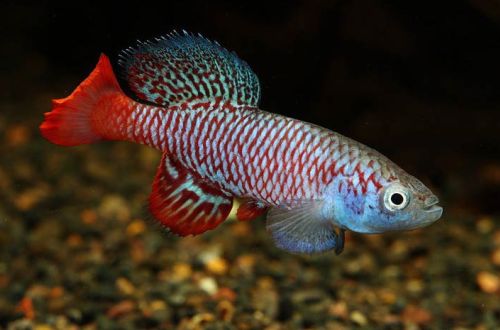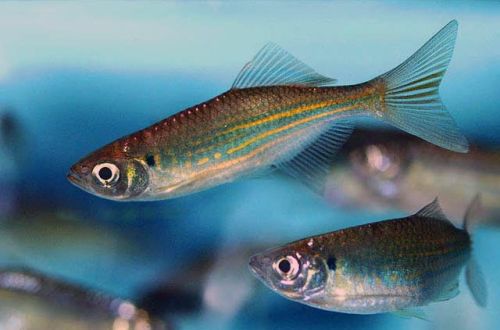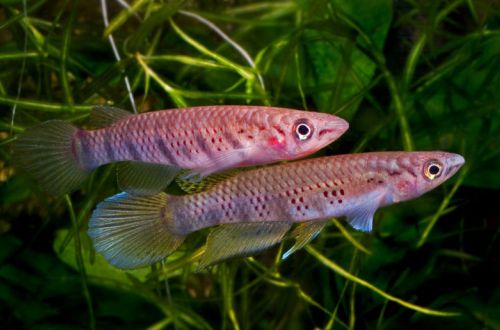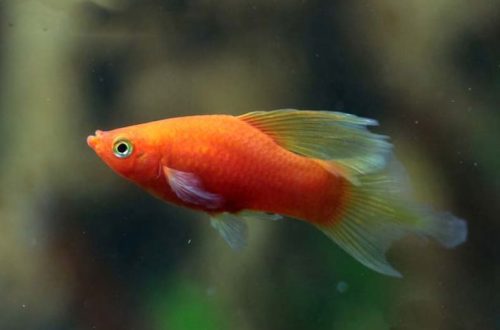
Notobranchius Kirka
Notobranchius Kirk, scientific name Nothobranchius kirki, belongs to the family Nothobranchiidae (Notobranchius or African rivulins). A bright fish with a difficult disposition (in relation to males). It is considered relatively easy to keep, but difficult to breed. They are distinguished by an unusual breeding strategy and a rather short lifespan of only a couple of seasons.

Contents
Habitat
Occurs from the African continent from the territory of the rift valleys in the territory of modern Malawi and Mozambique. Inhabits river systems flowing into lakes Chilva and Chiuta. A typical biotope is periodically dry shallow streams with silty substrates.
Brief information:
- The volume of the aquarium – from 40 liters.
- Temperature – 20-25°C
- Value pH — 6.0–7.0
- Water hardness – soft (4-10 dGH)
- Substrate type – dark soft
- Lighting – subdued
- Brackish water – no
- Water movement – little or no
- The size of the fish is 5–6 cm.
- Nutrition – any food rich in protein
- Compatibility – in a group with one male and several females
Description
Adults reach a length of 5–6 cm. The scales of males are blue with a contrasting red edge. Red shades, including on the fins, begin to predominate in the back of the body. The blue color is completely absent on the tail. The females are not so brightly colored. The main color is light grey.
Food
The usual diet should be clarified with the sellers. Usually, it consists of live and frozen foods, but some breeders are accustoming fish to alternative dry foods.
Maintenance and care, arrangement of the aquarium
For 3–4 fish, a small aquarium with a volume of 30–40 liters and a depth of about 25–30 cm is sufficient. A layer of dark soft soil is used in the design. If breeding is planned, then it is worth providing a special removable spawning substrate for Killy fish. Thickets of plants and driftwood will be excellent shelters. In addition, floating plants will prevent fish from jumping out and serve as an additional means of shading the aquarium. Bright light adversely affects the color.
Relatively easy to maintain. They are considered a hardy species, which does not eliminate the need for regular maintenance of the aquarium. It is important to regularly replace part of the water with fresh water and remove organic waste (feed leftovers, excrement).
Behavior and Compatibility
Males are very temperamental and do not tolerate the presence of rivals in their territory. In a small tank, it is worth maintaining a group size of one male and several females. Compatible with other peaceful species that can live in similar cramped conditions. However, closely related species should be excluded.
Breeding / breeding
In nature, spawning occurs at the end of the wet season. Eggs are laid on the surface of soft soil. When the reservoir dries up, the fertilized eggs go into a state of diapause for several months, until the first rains come.
When breeding at home, you will need to reproduce such external changes. A few days after the end of spawning, a layer of soil with eggs is removed from the water, slightly squeezed and placed in an open container, where further drying takes place at a temperature of 20–22°C. It should reach a state of slightly damp ground. Then the substrate with caviar is placed in a closed container and placed in a dark place for 5 months. At the end of the incubation period, the eggs are poured with water at a temperature of 18–20°C. The fry appear within a few hours. Gradually the temperature is raised to 26°C.
Fish diseases
Hardy and unpretentious fish. Diseases manifest themselves only with a significant deterioration in the conditions of detention. In a balanced ecosystem, health problems usually do not occur. For more information on symptoms and treatments, see the Aquarium Fish Diseases section.





